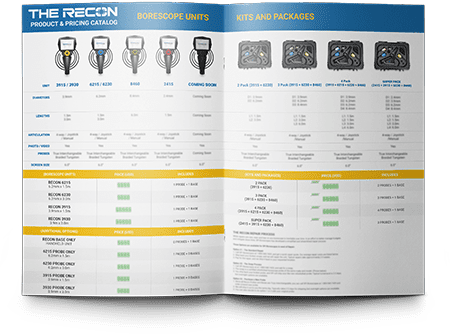In the aviation industry, the use of borescopes is common as this is an invaluable inspection tool, and inspections are not only needed, they are required for most aircraft. Because of this, having a high-quality and reliable aviation borescope is a must for any professional airplane mechanic and aircraft operator.
Differences in Inspections
The requirements for inspections do vary amongst the different kinds of aircraft and their intended use. An aircraft must have an inspection plan based on their individual requirements, and many commercial, for hire, and military aircraft have stringent inspection requirements that require the inspections to happen every 100 hours of flight time. This time can come quickly for aircraft that are in heavy use, which most commercial and military crafts are. Even if you operate an aircraft that doesn’t fall under the requirements, a thorough 100-hour check is still recommended if you put a lot of flight time on an aircraft each year, which would fall in the 200 hours a year zone.
The 100-hour inspection is not the same as an annual inspection. An annual inspection must happen within a 12-month period in order to obtain proper permitting. What these inspections do have in common is that they are largely visual inspections, therefore requires special equipment like the aviation borescope, so they don’t have to conduct a teardown during each inspection.
Why a 100 Hour Inspection?
In the terms of the 100-hour inspection, the main purpose is to identify any worn or damaged parts to minimize the risk of failure. When an aircraft is used for commercial, for hire, or military purposes, it tends to undergo a good amount of stress and strain. While aircraft are made to withstand a lot of different conditions, high temperatures at the engine, long hours of use, environmental conditions, contamination of the fluids, and many other factors can play a big part in the early degradation of parts. The engine, electrical system, landing gear, and body panels are especially susceptible to damaging influences from the environment and ongoing use.
So what exactly happens during a 100 hour inspection? For starters, the 100 hour inspection usually doesn’t happen all at once, and all at exactly 100 hours. Since there is so much involved, these are lengthy inspections, even when the mechanic has the best inspection tools. The 100 hour aircraft inspection cycle is usually conducted at 25 hour intervals, so every 25 hours of flight, the aircraft is inspected. The inspection is considered to be completed once the final 25 hour inspection is completed and endorsed.
What Happens During Each 100 Hour Inspection?
Inspections that are required every 100 hours are considered to be “non-destructive inspections” in nature that are meant to determine the airworthiness of an aircraft without extensive teardown. Tools like articulating borescopes for aircrafts are used to inspect components like:
Turbine Engine Internal Components
Turbine Engine Accessories
Cooling Blades
Wiring
Body Panels
While these parts are being inspected, they are looking for even the slightest signs of cracks, corrosion, tear, buildup, fluid contamination, poor lubrication, and more. Most issues, if caught early enough, are easy to fix before they cause further damage, or affect the other components. Using an aviation borescope makes these inspections go as quickly and accurately as possible, and can help the operator save thousands in damages that could occur later on.
Related Articles
Learn more about aviation borescopes and their real-world applications
Aviation Body & Engine
Aviation maintenance is a large and crucial part of the aviation industry as aircraft and engines are in constant need of inspection, preventative maintenance, and repair in order to keep these flying machines, running, effective and safe….
Most common aircraft turbine problems are avoidable with the use of an aviation borescopes to detect problems before they become disasters!
An aviation borescope is an invaluable piece of inspection equipment that any professional aircraft owner and mechanic need to have in their toolbox. Using one of these high-tech inspection tools can help….
6 Warning Signs to Look for When Performing an Aviation Borescope Inspection on an Aircraft Engine
Aviation borescope inspection is an important practice on any aircraft. Inspection requirements vary by craft type, and usage. For example, commercial and military aircraft are required ….
3 Types of Rocket Engines Used for Space Travel that Undergo Aviation Borescope Inspections
Space travel almost seems like its routed in pure magic, but a ton of engineering and highly advanced parts go into to make this ‘magic’ actually possible. Whether it’s manned or unmanned space crafts ….
Why a Military Aircraft Needs More Aviation Borescope Inspections Than Commercial Aircrafts
In the United States Military, there are currently over 13,000 aircraft in service to help protect our country. These include everything from transport aircraft, fighter aircraft, trainer aircraft, and so much more….
3 Most Commonly Used Commercial Aircrafts that Utilize Aviation Borescopes
The inspection process of an aircraft is vital to maintaining the right performance and operation standards of any and all aircrafts. Without a proper inspection, an aircraft is likely to run with undiagnosed issues….


